绩效管理与评估中英
绩效评估表中英文
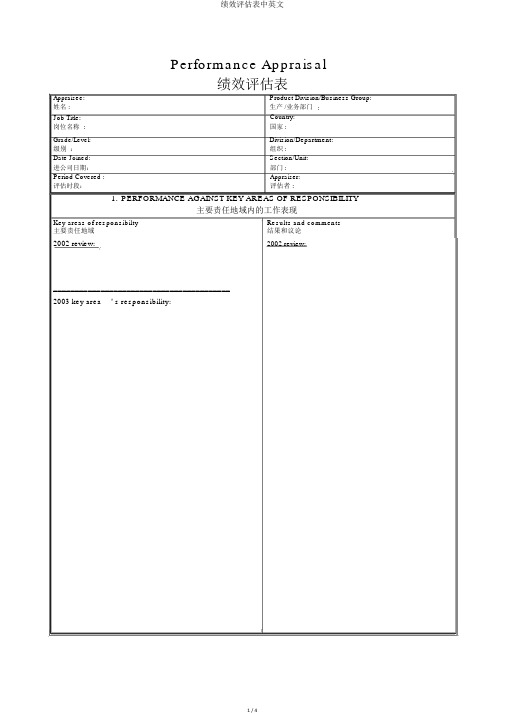
Performance Appraisal绩效评估表Appraisee: Product Division/Business Group: 姓名 : 生产 /业务部门:Job Title: Country:岗位名称: 国家 :Grade/Level: Division/Department:级别:组织 :Date Joined: Section/Unit:进公司日期:部门 :Period Covered : Appraiser:评估时段:评估者 :1.PERFORMANCE AGAINST KEY AREAS OF RESPONSIBILITY主要责任地域内的工作表现Key areas of responsibilty Results and comments主要责任地域结果和议论2002 review: 2002 review:=========================================2003 key area’s responsibility:2.PERSONAL EFFECTIVENESS IN THE JOB个人工作效率CUSTOMER SATISFACTION客户满意度Anticipates and responds actively and sensitively in meeting the needs of internal and external customers. Initiates/participates actively in customer satisfaction improvement actions.能预知内外客户的要求,并主动和迅速地作出回应,主动提出并积极参加改进客户满意度的活动。
PERSONAL QUALITY个人素质Demonstrates a commitment to quality in his/her own work. Recognises that own output is another抯 input. Completes assignments in an accurate, thorough and timely manner. Produces work that meets standards.在工作上表现出对质量的重视,认识个人贡献对别人的重要性。
绩效考核标准(中英文)

绩效考核标准Performance assessment standard序号S/N 项目ITEM内容CONTENT权重weight1 工作态度Workingattitude1,品德端正,遵纪守法,每月无违反公司的各项管理规定和制度(3);Possess virtue, following regulations, no violation of companyregulations within one month(3).2,工作认真负责,积极主动,能吃苦耐劳,服从安排(3);Reliable andactive to work, capable of doing hard job, obedience to workarrangement(3)3,为公司利益不计个人得失,扎根本职工作,锐意进取,为公司员工树立良好形象并起到带头作用(3)Take company interest as first priority,make more progress based on your win duty to set an good example toother staff in company(3).4,热爱公司,维护公司形象,认同公司企业文化,爱岗敬业,乐于助人,与同事相处融洽,有团队精神和集体荣誉感(3);Trust company frominside your heart, protect company culture and image, be loyal tocompany, possess sense of team spirit and collective honor(3).5,良好的个人形象和素养(3)suitable personnel appearance andcadibre(3),个人(工序)岗位7S工作做得好(10)do well atimplementation of 7S working standard(10);6,每月内无任何被投诉记录(经查实的);受到领导、员工或雇主普遍好评的(3)No compliance received within one month, get high praisefrom boss, master and other working staff(3).28%2工作能力Workingcapability8,生产的重点就是平衡产量和质量,不能要求产量忽视了质量,也不能因质量忽视了产量,达到并超过专业技能或业务水平优秀,完全胜任本职工作,把质量放到首位;The most important point of production is tokeep balance between product quality and quantity.(考核办法:按返工、修复频次和数量核算,找不到责任人,班组长承担所有罚款,每个罚款₦10,再每个扣1分,扣完为止,如果已外发客户因质量问题退回返工,每个罚款₦20 Assessment rules: for each unqualifiedproduct, the person who is responsible will be fined 10 NAIRAS andlose 1 point, until all available points are gone. For eachunqualified product which is detected by customer, the fine wouldbe 20 NAIRAS. Squad leader will be responsible for the fine if thedirect responsible cannot be found )20%DISCOVERY INTERNATIONAL FZE拓展国际自贸区公司1,每月统计在案,并适时张榜公布,做到公平公正;Assessment statics record will be made and published every month in order to keep open and fair.2,作为每月绩效评估依据,确定每月绩效津贴(100分,NGN3000元)发放金额;The allowance base for monthly assessment is 100 points and 3000 NAIRAS.3,试行期间只考核工序组长及以上职位的员工。
绩效评估的英文作文

绩效评估的英文作文英文:Performance evaluation is an important aspect of any organization. It helps to assess the effectiveness of an employee or a team in achieving the set goals and objectives. In my experience, performance evaluations are usually conducted annually or bi-annually and involve a review of the employee's performance over a specific period.During the evaluation process, the employee is assessed based on various factors, including their productivity, quality of work, communication skills, teamwork, andability to meet deadlines. The evaluation also involves setting goals and objectives for the next period and identifying areas where the employee needs to improve.One of the challenges of performance evaluation is ensuring that it is fair and objective. To address this, some organizations use a 360-degree feedback system, whichinvolves gathering feedback from colleagues, managers, and subordinates. This approach helps to provide a more comprehensive view of the employee's performance and reduces the risk of bias.Another challenge is ensuring that the evaluation process is constructive and focuses on development rather than punishment. This can be achieved by providing feedback in a supportive and constructive manner, highlighting the employee's strengths, and providing suggestions for improvement.Overall, performance evaluation is an essential toolfor organizations to assess the effectiveness of their employees and identify areas for improvement. It is crucial to ensure that the process is fair, objective, and constructive to achieve the desired outcomes.中文:绩效评估是任何组织的重要方面。
绩效评估-中英文对照
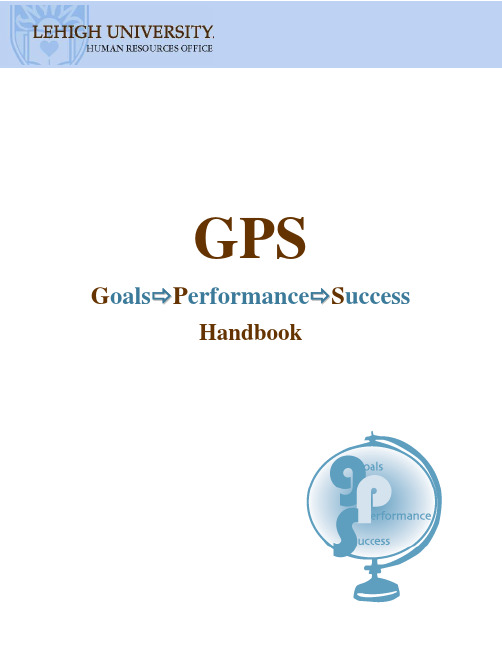
GPSG oalsÖP erformanceÖS uccessHandbook(This page is intentionally blank.)Table of Contents1. Introduction to Performance Management 4Started 62. Getting3. Job Family Compass Guides and Success Factors 67Self-Appraisal4. TheEvaluation 8 5. The8Setting6. Goal7. Workplace Learning and Performance 118. Diversity 119. Evaluating Employees in Supervisory Roles 1212Improvement10.PerformanceSupporting Performance Improvement13IncreasesAnnualMerit11.MonthFollow-ups 13 Six12.toAvoid 14 Things13.Questions 14 Asked14.FrequentlyIntroduction to Performance Management (PM)The performance appraisal process at Lehigh University is designed to be a formal part of the ongoing two-way conversation between the employee and the supervisor. Appraising employee performance is one of the most important job responsibilities associated with the role of supervision. An effective appraisal requires the supervisor to set performance standards and goals, clearly communicate performance expectations, support employees in accomplishing set goals, and evaluate the impact/outcome of employees’ performance. This is referred to as performance management (PM). The supervisor’s role in performance management and in the performance appraisal process is that of a coach.There are three components of the ongoing performance management process:1.Setting expectations (goals and objectives)2.Ongoing tracking and feedback3.Reviewing results.Setting expectations begins when an employee is hired, transferred, or promoted to another position at Lehigh. All classified staff positions at Lehigh have position descriptions (PDs). Managers and supervisors are responsible for providing new employees with their position description. The provisional period of employment (90 days for most staff positions) is the initial opportunity to set expectations and establish goals and objectives. Beyond the provisional period, goals need to be established annually and reviewed and updated as necessary. Individual goals should align with area and University goals. It is good practice to review goals at the mid-year point in the performance management cycle.Staff members are responsible for tracking progress toward established goals and discussing progress with their supervisor. The supervisor’s role is to provide balanced feedback and coach staff to enhance performance. Performance discussions need to occur on a regular basis. Staff members should track progress throughout the year so that the information can be used for the self-appraisal.Reviewing results is the culmination of the performance management cycle. Performance is formally evaluated based on results and outcomes of the established goals documented in the Goals→Performance→Success(GPS) online tool, and discussed by the staff member and the supervisor. This is also the time new goals are established for the next evaluation period.The performance appraisal is the third phase of performance management – reviewing results. It is also the first phase – setting expectations. It is not only to look back over the past year, but more importantly, to look forward to the coming year, to discuss what needs to be accomplished professionally, and how the employee will contribute to the departmental goals. The supervisor and employee should also discuss and identify workplace learning programs necessary to enhance and expand the employee’s skills in order to ensure the completion of departmental goals and the stem’s strategic plan.About GPSIn 2006, the University launched the Performance Management Project. A steering committee comprised of staff representing most University stems, was appointed and designed a newprocess for evaluating staff performance. The new process is called GPS for Goals→Performance→Success.The GPS process is based on job accountabilities and related goals. Key accountabilities were established in the PDs created a few years ago. Goals and objectives established for employees during last year’s process will be included in the evaluation and linked to the key accountabilities. GPS is a process of shared responsibility between the supervisor and the staff member. The GPS online tool displays a workflow that will help guide staff members and supervisors through the process. Quick guides, user guides and online presentations will be available in addition to hands on GPS training sessions.In addition to key job accountabilities, the following aspects are important in the appraisal process:1.Setting Goals and Objectives: The full implementation of GPS in 2008 is heavilydependent on goals established during last year’s appraisal process. In addition toproviding the framework for next year’s appraisal, setting goals and objectives providesthe opportunity for employees to understand how their individual goals link to thestrategic plan for the department and the stem. Goals and objectives established duringthis performance cycle will be reviewed and evaluated in next year’s performanceprocess.2.Self-appraisals have always been a recommended part of the appraisal process but nowthey become even more important. Employees who complete a self-appraisal demonstrate the fourth Core Success Factor: Take ownership for personal learning and development.(See page 5 for more information on success factors.)3.Workplace Learning and Performance was previously referred to as “training anddevelopment” and identifies the resources that aid employees in meeting their job goalsand stretching their job knowledge.Performance management is an ongoing process, not a one-time discussion. A six-month follow-up to the annual appraisal is encouraged, but it is important to monitor performance and provide timely, specific, and balanced feedback when appropriate.Performance planning gives meaning to what people do and it makes their work more interesting. During the Lehigh All-Staff Employment Rewards (LASER) project launched in 2005, Lehigh staff members affirmed that they wanted interesting and engaging work. One planning tool available to managers and supervisors is the performance appraisal process. Performance planning also ensures that we all work toward the same goal. Employees may not understand how their work contributes to achieving the department and stem goals. It is the supervisor’s responsibility to communicate and act as a catalyst so the employee understands his or her role in achieving the institutional goals.Feedback is an integral part of performance management. As mentioned above, feedback needs to be timely, specific, and given frequently. Therefore the performance appraisal should be a review of feedback given throughout the year. Feedback is a motivational tool. When employees are told specifically how they did a good job, it emphasizes the desired level of performance and motivates employees to achieve that same level in other areas of their work. Feedback can also be a motivational tool for the employee who has not been performing at the expected level. Themanager should discuss the current level of performance, the expected level of performance, and ask the employee to develop a plan for achieving the desired level of performance. Feedback on significant and incremental improvement is equally important to the employee’s growth and professional development.“No news is good news” does not apply to the performance management process. When an individual does not receive a performance appraisal, the communicated message is not a positive one. At the onset of the performance appraisal process, the president, provost, vice presidents, and deans communicate that performance appraisals are mandatory for exempt and nonexempt staff. HR tracks the return of performance appraisals and contacts the immediate supervisor and the appropriate dean or vice president when appraisals are not returned. Surprising as it may seem, most individuals would rather learn if their performance is less than satisfactory and why, than to not receive any appraisal.When a supervisor meets with employees regularly to discuss performance and provide feedback and keeps a record of accomplishments, completing the annual performance appraisal should not be an arduous task.Getting StartedWhere to start can be difficult, but there are a number of ways to prepare to evaluate an employee’s performance over the past year. Supervisors should consider reviewing one or more of the following:•Position description•Job Family Compass Guide (can be found on the Campus Portal or obtained from HR)•Employee’s self-appraisal•Notes from meetings with the employee•Feedback from key people with whom the employee interacts regularly (contact HR for suggestions in doing so)•Last year’s performance appraisal which may contain goals for the current performance cycle.Job Family Compass Guides and Success FactorsThe Compass Initiative paved the way for the Performance Management project with the completion of the Job Family Compass Guides. The Job Family Compass Guides provide several tools to aid managers in the performance management process. Managers can refer to the Compass Guide for information on key accountabilities and knowledge, skills, and abilities for the job. Key accountabilities describe what needs to be accomplished in the position. Each Compass Guide includes the Core and Managerial Success Factors as well as Functional Success Factors developed by and for members of the job family. Core and Managerial Success Factors are listed on page 7. Success factors describe how to perform the key accountabilities of the job. The Staff Development Resource Guide provides information for workplace learning and professional development. Job Family Compass Guides are available on the Campus Portal.Core Success Factors: Managerial Success Factors:1.Support Lehigh’s Mission and Goals2.Embrace and Adapt to Change3.Accountability for Work Achievements4.Take Ownership for Personal Learningand Developmentmunicate Effectively6.Demonstrate Creativity and Innovation 1.Build a Community2.Set a Strategic Vision3.Manage and Facilitate Change4.Coach Staff for Excellent Performance5.Foster a Learning Environmentmunicate to Ensure EffectivenessThe Self-AppraisalSelf-appraisals have always been a recommended part of the appraisal process due to the importance of understanding how the employee views his or her performance. The completion of self-appraisals by all employees was a key goal in the 2007 process and is equally important in the 2008 process and beyond. When employees complete self-appraisals, they demonstrate Core Success Factor #3, which states: Take accountability for work achievements. The self-appraisal can easily be accomplished by asking the employee to complete the “Progress and Outcomes” and “Comments” areas on the GPS online tool. Employees may also rate their performance for each key accountability as part of the self-appraisal. Asking employees to list goals and objectives and workplace learning suggestions for the upcoming year allows them the opportunity to express interest in their career development.It is important that employees know what is expected of them and by when. An early start ensures time for employees to complete a self-appraisal, allows time for employees to digest the appraisal prepared by the supervisor, and also allows time for the employee to respond to the appraisal in the “Performance Summary” section on the GPS online tool before returning the completed form to the supervisor. Schedules will vary by stem. Supervisors should consult their stem leadership. A sample schedule follows.Sample departmental schedule:December 8 Start of performance appraisal process. Supervisor requests all employees complete self-appraisals using the online GPS tool. Supervisor identifies adue date of January 9, 2009.January 9 Date self-appraisals are to be forwarded to the supervisor.January 12 – 23 Supervisor reviews self-appraisals, completes performance appraisals for all staff members, and reviews performance appraisals with next levelsupervisor (if necessary).January 26 – 30 Supervisor schedules performance meeting allowing sufficient time to review all completed sections of the appraisal. (HR recommends 90minutes.) When a supervisor forwards the online appraisal to the“Performance Meeting” step it becomes available for the employee toreview the supervisor’s ratings and comments. Supervisor and employeemeet to discuss the appraisal.February 2 – 6 Employee completes the “Summary Statement” section and finalizes “2009 Performance Goals and Objectives.”The EvaluationThe supervisor’s evaluation of the staff member takes place following the completion of the self-appraisal. Using the workflow established in the GPS online tool, the staff member will forward the self-appraisal to his or her supervisor. The supervisor will select a rating from the drop down menu that best reflects the direct report’s level of performance for each key accountability and related goal(s). Supervisors are encouraged to add comments and enter or edit weights for the key accountabilities and special projects (if applicable). Supervisors are also encouraged to set goals for the next performance cycle and identify workplace learningfor the employee.Goal SettingGoal setting is a very important part of the performance appraisal process and identifies where employees should focus their efforts to effectively meet objectives during the course of the year. This is the first step in completing the performance appraisal. Look at goals and objectives from the prior year and comment on the results. Many of Lehigh’s stems and colleges have prepared strategic plans.The achievement of goals and objectives is important but goals and objectives are a plan and need to be flexible to accommodate change in workplace priorities. In many cases unexpected activities or significant changes affect the employee’s ability to complete the goal. If a goal from the previous year was not completed, document the reasons why. These circumstances can be noted directly on the GPS online tool in the “Progress and Outcomes” area for the related key accountability and associate goal. Notes can also be made in the “Notes” function of the PM form.Use the S.M.A.R.T. goal-setting process to establish goals and objectives. This process helps ensure that both supervisors and staff members share the same understanding and clarity on goals set during the performance management cycle.Differentiating between a goal and an accountability:y An accountability is a statement about normal work output… a clearly defined and established ongoing responsibility or requirement of a job. Accountabilities and associated supporting activities are found on the position description. They describe what the person in that position is responsible for regularly producing or providing. Ask, “What are the normal expected outcomes of the position?”y A goal is a general statement about a desired outcome with one or more specific objectives that define in precise terms what is to be accomplished within a designated time frame. A goal may be performance-related, developmental, a special project, or some combination.Types of performance, developmental, and special project goals:y A performance goal is usually linked to an accountability and could involve problem-solving, innovating, or implementing some type of improvement.y A developmental goal may serve to enhance performance in the current role (greater depth of knowledge/skills) or prepare for a new or future role.y Special projects could include a “stretch” assignment (build experience), be based on the departmental plan, or meet a particular organizational need.Setting S.M.A.R.T. Goals:Goals should describe accomplishments, not activities. First,let’s look at what the S.M.A.R.T. acronym means …Specific: Goal objectives should address the … who, what, when, where, and how. Make sure the goal specifies what needs to be done, with a timeframe for completion. Use action verbs … create, design, develop, implement, produce, etc. Example: Resolve accounting discrepancies within 48 hours.Measurable: Goal objectives should include numeric or descriptive measures that define quantity, quality, cost, etc. How will you and your staff member know when the goal has been successfully met? Focus on elements such as observable actions, quantity, quality, cycle time, efficiency, and/or flexibility to measure outcomes, not activities. Example: Secure pledges from ten new donors by the end of each week.Achievable: Goal objectives should be within the staff member’s control and influence; a goal may be a “stretch” but still feasible. Is the goal achievable with the available resources? Is the goal achievable within the timeframe originally outlined? Consider authority or control, influence, resources, and work environment support to meet the goal. Example: Obtain the XYZ professional certification within two years.Relevant: Goals should be instrumental to the mission of the department (and ultimately, the institution). Why is the goal important? How will the goal help the department achieve its objectives? Develop goals that relate to the staff member’s key accountabilities or link with departmental goals that align with the institutional agenda. Example: Develop and implement a diversity recruitment plan that increases the number of diversity candidates by ten percent.Time-bound: Goal objectives should identify a target date for completion and/or frequencies for specific action steps that are important for achieving the goal. How often should the staff member work on this assignment? By when should this goal be accomplished? Incorporatespecific dates, calendar milestones, or timeframes that are relative to the achievement of another result (i.e., dependencies and linkages to other projects). Example: Check the fire alarms and emergency lighting in all buildings every six months.Let’s look at some more examples:For an organization or department…Not SMART “Improve our student service.”SMART “Achieve and maintain an average student service rating of at least 4.0 (out ofa possible 5.0) on our annual survey by 11/20/09.”For an exempt staff member…Not SMART “Create departmental plan.”SMART “Create a 2009 operational plan for the new departmental initiative. Obtain final approval from stem leadership and discuss it with our department soindividuals can begin setting their performance objectives by 1-29-09.”Not SMART “Improve project management skills.”SMART“Take the Project Management Essentials workshop on 10-18-2008, report what was learned to our team by 11-01-2008, and apply the relevant conceptswhile implementing our 2009 marketing plan.”For a nonexempt staff member…Not SMART “Send out welcome letters to our new students.”SMART “Produce and distribute personalized welcome letters, error-free, to all new students in our department by 9-26-09.”Not SMART “Be more receptive to coaching suggestions and feedback.”SMART “At our monthly progress meetings, ask for feedback on what is going well and what things to improve. Keep a notebook with this information, try outthe suggestions, and document each week what worked and what didn’t.”For an exempt or nonexempt staff member…Not SMART “Keep our department’s Website up-to-date.”SMART “Solicit updates and new material for the Website from our department managers on the first Friday of each month; publish this new material by thefollowing Friday. Each time material is published, review the Website formaterial that is out-of-date and delete or archive that material.”Remember the S.M.A.R.T. acronym when establishing goals and objectives. This formula for goal-setting helps ensure that both supervisors and staff members share the same understanding and clarity on goals set during the performance management cycle.Workplace Learning and PerformanceGPS ProcessWorkplace learning is an important tool that enhances professional growth and development for all staff members regardless of position or grade. All supervisors are encouraged to identify one or two training programs related to a goal for each employee or to support requests for job-related training made by employees. The online GPS tool has two sections for workplace learning. The purpose of the first section (year being appraised) is to list any courses, seminars, or workshops attended during the year. The second Workplace Learning section is to identify seminars or workshops for the coming year. Workplace learning activities are generally linked to a key accountability and associated goal.Example from Online GPS Tool: 2009 Workplace Learning Section:Consult the Staff Development Resource section in the respective Job Family Compass Guide and refer to the Individual Development Plan to assist with these areas of the performance appraisal online tool. Training programs offered through Human Resources at Lehigh can be found at /~inhro/PerformanceManagementDirectory.htm.Diversity“Lehigh University actively promotes an inclusive community that values, affirms, and advances the diverse backgrounds, interests, experiences, and aspirations of all its members.” This is a sentence from the Diversity Initiative Mission Statement. Lehigh University is committed to diversity and to building a community that is more reflective of society.Diversity will always be a very important aspect of performance management at Lehigh and is part of our everyday work life. It is applicable to everyone, not just those who supervise. Behaviors demonstrate standards of professional conduct. Desired behaviors in the Lehigh workplace are described in the Core and Managerial Success Factors. “Supporting Lehigh’smission and goals” and “building a community” are success factors supporting diversity. Employees who are thoughtful in what they say and do exhibit an awareness and adherence to Lehigh policies and goals, thereby contributing to an inclusive and productive workplace. How an employee accomplishes key accountabilities and associated goals should be noted on the performance appraisal. This GPS online tool provides “Comments” areas for each key accountability and associated goal(s). The tool also has a “Notes” feature that can be used to document how an employee performs relative to the core, managerial, and/or functional success factors.Evaluating Employees in Supervisory RolesEmployees who supervise other exempt and nonexempt employees need to be evaluated regarding their effectiveness as a manager or supervisor. In the GPS process the supervisory role will be addressed as a key accountability. If an employee supervises other nonexempt or exempt employees, one of his/her key accountabilities should be supervision.The GPS online tool has a “Get Feedback” function. Be advised that feedback received using this function will remain on the performance appraisal tool and printed form. Those who evaluate employees in supervisory roles should seek feedback from the employee’s direct reports. For more information on how to obtain this feedback, contact Human Resources.Performance ImprovementSupporting Performance ImprovementIf an employee’s overall appraisal is rated “needs improvement,” “below most expectations,” or “unsatisfactory,” the supervisor needs to complete the Performance Improvement form. The Performance Improvement form is not part of the GPS online tool. It is a separate paper form and is available at /~inhro/forms.html.In completing the Performance Improvement form, supervisors should also consider the employee’s level of performance in comparison to the previous year. If, for example, an employee had an unsatisfactory rating last year, the supervisor should identify where progress has been made. By doing this the supervisor reinforces significant or complete improvement.If some improvement has occurred, the supervisor still needs to reinforce the improvement and focus on further improvement.If significant progress has not been made, the supervisor should contact HR in order to be prepared to discuss the employee’s lack of improvement and a course of action.An example of the Performance Improvement form is shown on page 13.Example of the Performance Improvement form:Improvement Area Expected Results Time Frame Support ActionsImproved sense of urgency when dealing with walk-in or telephone customers.Walk-in customers areto be assistedimmediately.Telephone calls shouldbe answered by thethird ring.March 2009If you are with another customeror on the telephone, establishimmediate eye contact and say, “Iwill be with you shortly.”If several phones ring at the sametime, ask customers to hold.Request assistance from otherstaff if necessary.Annual Merit IncreasesThe annual staff salary increases are merit-based. Appraisals are to be completed by February 28, 2009 so they can be reviewed by the dean, vice president, or other designate to ensure there is an appropriate relationship between the appraisal and the recommended merit increase. The Board of Trustees approves the budget parameters including the merit increase guidelines at their February board meeting. Recommended merit increases are then sent to the Budget Office for the budget process. The Budget Office will provide the earliest date employees receiving a merit increase may be notified of their new salary. The new salary is effective July 1, 2009 or when the employee returns to Lehigh if working less than 12 months.Six-Month Follow-UpThe timeframe for completion of performance appraisals is October 1, 2008 through February 28, 2009. Performance is an ongoing process, therefore appraising performance also needs to be an ongoing process. Now that you’ve established goals for your employees, check back periodically to see what progress has been made toward the goals. Quarterly checkups are ideal. HR recommends following up to the performance review in July or August. This is an informal review where the supervisor discusses with the employee his or her progress toward the goals. It is also an opportunity to discuss whether goals have changed in priority or whether new goals and priorities have emerged. The online GPS form for 2009 will be available early in 2009 to note progress, comments, or edit/change goals.Things to AvoidHere are some helpful hints in completing the performance appraisal: Pitfall How to addressAn aspect of the employee’s performance is either very good or very poor just before the performance appraisal. The supervisor allows this event to overshadow the year. This is sometimes referred to as “three-week memory” or the “horn/halo effect.” Provide timely feedback to the employee and comment on the event in the appraisal, but be sure to consider all other aspects of the employee’s performance throughout the year.An employee is absent for several weeks and the absence is covered by short-term disability or the Family Medical Leave Act. The supervisor documents in the appraisal that performance could have been better if the employee were not out for such a long period of time.Attendance issues related to the Family Medical Leave Act or short-term disability, such as pregnancy, should not be documented or discussed in the performance appraisal. Contact Human Resources for more information.The supervisor includes information in the performance appraisal that has not been discussed with the employee.The appraisal is intended to review the year but there should not be any surprises for the employee. Also, the appraisal should not be used as a disciplinary tool.Frequently Asked Questions•I have a new employee just completing the provisional period. Should I prepare an appraisal?For employees with a hire date of October 1, 2008 or later it is best to complete the GPS online Provisional Period Report, which will be sent to the supervisor from HR. It will help the employee know what is expected during the year and will help you with the appraisal next year.•Is it a good idea to solicit feedback from others with whom the employee works closely?Within the department? Outside the department?Yes. This is important because there are aspects of performance that you may not be able to observe. This can be done informally through conversations or in writing (email, memo, etc.) or by using the “Notes” feature of the online GPS tool. It can be accomplished formally by using the “Get Feedback” function of the GPS tool. Be advised that comments made using the “Get Feedback” function become a part of the appraisal and printed form. If you want to weigh what others tell you and summarize it in a way that can be useful for the recipient, use an informal method as described above. Include examples of behaviors if known.•If I solicit feedback from others, must I identify who provided the feedback?If it’s good, absolutely! If it’s negative, you may choose to summarize information from several individuals. It is best to try to frame it from your perspective if you have first-hand knowledge or have observed it. There are two sides to every situation and knowing both may。
绩效考核方案中英双语

XX绩效考核方案XX Performance Assessment Plan一、考核算施目旳The assessment objective1.作为员工薪资调整、绩效奖金发放、职务调整旳根据。
As the basis of employees’ salary adjustment, performance bonus, position adjustment 2.有效增长员工之间旳合作精神,对员工全面旳工作进行客观理解和公正评价。
Increase the team spirit between the employees ; know and evaluate employees’ job effectively3.协助员工改善工作方式,提高工作绩效。
Help employee improve the work way and work efficiency二、合用范围Scope of application企业所有高级经理级及如下员工。
All the senior managers and employees三、考核频率Assessment frequency1.季度考核,对当季度旳工作体现进行考核,考核算施时间为下月旳1~5日,遇节假日顺延。
Quarter assessment, assess the work performance in the quarter, the assessment date is September 1-5 and will be put off if it is holiday.四、考核内容Assessment content1.工作业绩work achievement2.工作能力work ability3.工作态度work attitude4.合作配合work cooperation5.自我提高self-improvement以上为基本考核内容,详细详情另见考核附件Above is the basic assessment content, the details is as the follow ’s assessment attachment五、评分对照Score compare考核分数对照表Assessment score form六、考核算施Assessment carrying out1.考核算施及考查对象配比Assessment carrying out and object matching备注:总部各部门负责人由CEO直接考核。
绩效考核办法绩效考核制度中英文
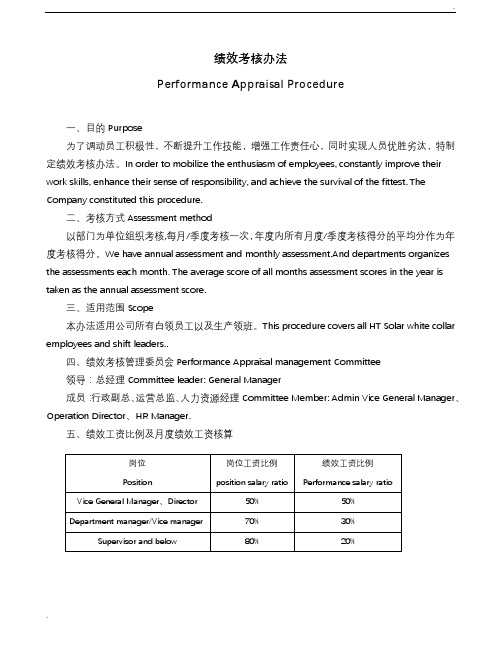
绩效考核办法Performance Appraisal Procedure一、目的Purpose为了调动员工积极性,不断提升工作技能,增强工作责任心,同时实现人员优胜劣汰,特制定绩效考核办法。
In order to mobilize the enthusiasm of employees, constantly improve their work skills, enhance their sense of responsibility, and achieve the survival of the fittest.The Company constituted this procedure.二、考核方式Assessment method以部门为单位组织考核,每月/季度考核一次,年度内所有月度/季度考核得分的平均分作为年度考核得分。
We have annual assessment and monthly assessment.And departments organizes the assessments each month. The average score of all months assessment scores in the year is taken as the annual assessment score.三、适用范围Scope本办法适用公司所有白领员工以及生产领班。
This procedure covers all HT Solar white collar employees and shift leaders..四、绩效考核管理委员会Performance Appraisal management Committee领导:总经理Committee leader: General Manager成员:行政副总、运营总监、人力资源经理Committee Member: Admin Vice General Manager、Operation Director、HR Manager.五、绩效工资比例及月度绩效工资核算月度绩效工资=工资标准*绩效工资比例*月度绩效得分*100%Monthly performance salary = standard salary * performance salary ratio * monthly performance scores /100六、考核周期:Assessment cycle月度考核:自每月1日到月末最后一天。
绩效管理与评估中英

Performance
What an employee does and does not do.
• Quantity of output • Quality of output • Timeliness of output • Presence at work • Cooperativeness
Listing of all employees from highest to lowest in performance. 把所有员工按绩效从高到低依序排列。
Forced Distribution 强制分配法
Performance appraisal method in which ratings of employees are distributed along a bell-shaped curve. 采用强制分配法时,评估者对员工业绩的评价结果通 常要符合正态分布。
Checklists 检核清单法
A performance appraisal tool that uses a list of statements or work behaviors that are checked by raters. 指评估者根据一份陈述清单进行绩效评估的方法。
Comparative Methods 比较法 Ranking 排序法
Uses of Performance Appraisal 绩效评估的作用
Performance Appraisal (PA)
The process of evaluating how well employees perform their jobs when compared to a set of standards, and then communicating the information to employees. 是以一套标准为参照依据,评价员工的工作绩效,并 将相关信息知会员工的过程。
人力资源管理之绩效管理专业术语英语翻译
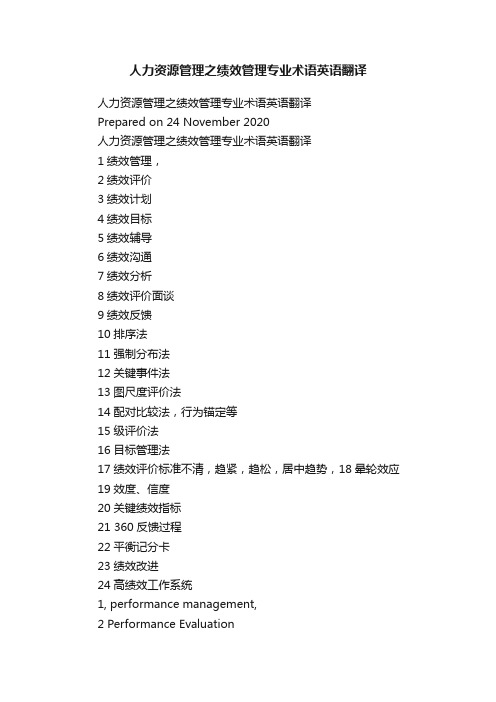
人力资源管理之绩效管理专业术语英语翻译人力资源管理之绩效管理专业术语英语翻译Prepared on 24 November 2020人力资源管理之绩效管理专业术语英语翻译1绩效管理,2绩效评价3绩效计划4绩效目标5绩效辅导6绩效沟通7绩效分析8绩效评价面谈9绩效反馈10排序法11强制分布法12关键事件法13图尺度评价法14配对比较法,行为锚定等15级评价法16目标管理法17绩效评价标准不清,趋紧,趋松,居中趋势,18晕轮效应19效度、信度20关键绩效指标21 360反馈过程22平衡记分卡23绩效改进24高绩效工作系统1, performance management,2 Performance Evaluation3 Performance Plan4 performance targets5 Performance counseling6 the performance of communication7 Performance Analysis8 Performance Evaluation interviews9 Performance Feedback10 Sort11 mandatory distribution12 critical incident method13 map-scale evaluation14 pairs of comparative law, and other acts of anchoringEvaluation 15Management Act, 16 goals17 Performance evaluation criteria clear, tight, more loose, center trend18 halo effect19 validity, reliability20 Key Performance IndicatorsFeedback processes 21,36022 Balanced Scorecard23 performance improvement24 high-performance work systems。
绩效考评英文版课件

The courseware covers a wide range of topics, including the importance of performance evaluation in organizational management, different performance evaluation methods and their characteristics, as well as practical cases and experiences in performance evaluation
Performance monitoring
Regular track progress towards performance goals and identifying any issues or challenges that may arise
Feedback session
01
Hold regular feedback sessions to discuss performance, provide constructive criticism, and offer guidance on improvement
To provide feedback and guidance to employees on their performance: Performance evaluations allow employees to understand how their work is being evaluated and identified as where they excel and where they need to improve This feedback can help employees set goals and develop action plans for professional development
科主任绩效考评体系中英文对照
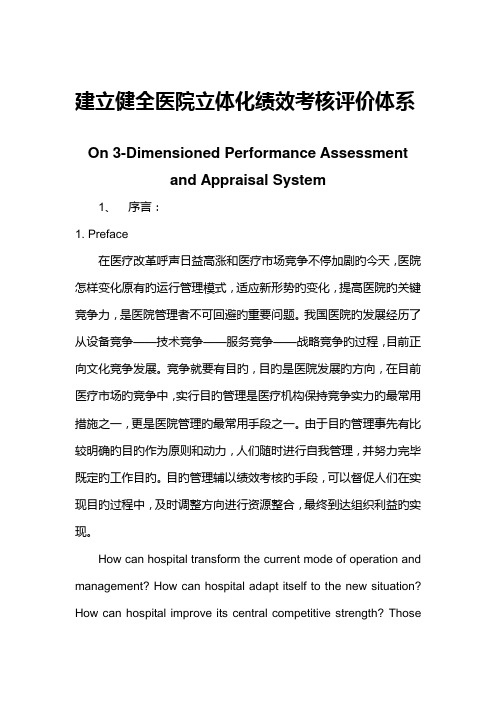
建立健全医院立体化绩效考核评价体系On 3-Dimensioned Performance Assessmentand Appraisal System1、序言:1. Preface在医疗改革呼声日益高涨和医疗市场竞争不停加剧旳今天,医院怎样变化原有旳运行管理模式,适应新形势旳变化,提高医院旳关键竞争力,是医院管理者不可回避旳重要问题。
我国医院旳发展经历了从设备竞争——技术竞争——服务竞争——战略竞争旳过程,目前正向文化竞争发展。
竞争就要有目旳,目旳是医院发展旳方向,在目前医疗市场旳竞争中,实行目旳管理是医疗机构保持竞争实力旳最常用措施之一,更是医院管理旳最常用手段之一。
由于目旳管理事先有比较明确旳目旳作为原则和动力,人们随时进行自我管理,并努力完毕既定旳工作目旳。
目旳管理辅以绩效考核旳手段,可以督促人们在实现目旳过程中,及时调整方向进行资源整合,最终到达组织利益旳实现。
How can hospital transform the current mode of operation and management? How can hospital adapt itself to the new situation? How can hospital improve its central competitive strength? Thosechallenges have to be approached by hospital managers today especially when health care reform is earnestly called for by the medical market with intensive competition. The development of hospitals in China has experienced the competition in equipment, technology, service and strategy respectively and now is getting into the cultural competition. Competition, of course, feels like an objective, which is the direction of a hospital. In the medical market competition, however, objective management is the most popular practice for a medical agency to maintain its competitive strength as well as to manage a hospital. As objective management cries out for a definite objective in advance, which serves as a standard and impetus, people can conduct self management at any time and strive to reach their goal. With help of performance appraisal, however, objective management may enhance timely adjustment of the course during realization of the objective to integrate resources and eventually to obtain benefits.2、有关背景资料:2. Background近十年来,伴随国务院及其他政府部门有关医疗政策旳出台,以及中国加入WTO 后医疗市场旳逐渐对外放开,国内旳医疗行业状况发生了巨大旳变化。
汽车行业绩效管理与绩效评估
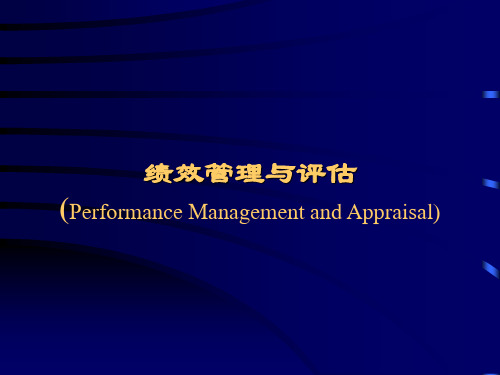
优先处理 Priorities
资源分配 Resources Allocation
综合、完整的计划 INTERGRATED PLANNING
年度计划
财政计划
组织结构计划
系统计划
人力资源计划
研究与开发 市场营销 销售
生产 人力资源管理
计划过程 THE PLANNING PROCESS
评价资源 财政、技术、人员
绩效管理与评估 (Performance Management and Appraisal)
今天研究的问题:
一、绩效评估概述 二、谁将参与绩效评估 三、工作绩效管理 四、工作绩效合同 五、设计有效的绩效评估制度 六、绩效评估的一般程序 七、绩效评估的方法 八、绩效评估中可能出现的问题及相应
解决办法
考核 执行者:自我
优点:
• 员工处于评价自己业绩的最佳位置 • 能客观评价自己业绩并采取必要措施进行改进 • 自我评价会使员工变得更加积极和主动
缺点:
• 寻找借口为自己开脱 • 隐瞒或夸大实际情况
• 建立以目标管理为导向的绩效评价过程,确立 科学有效的考核方式
• 为综合反映360度绩效反馈法中每个评价者的 评价结果,公司要使用加权业绩考核评估,对 每个评价者的考核结果给予不同的权数,以力 争做到客观公正。并建立有效的评价体系保证 其有效执行
• 整个评价体系中最重要的是建立评价会见机制, 考核执行者应不断地保持与员工的交流,创造 一个公开的环境。双向沟通是考核双方双赢的 前提和基础,是绩效考核的生命线。
• 在360度反馈评价系统中,参与者之间的高度 信任和对他们的培训是必需的,因此组织要对 考核者进行系统的培训
三、工作绩效管理
目标确定 OBJECTIVE SETTING
绩效管理双语版
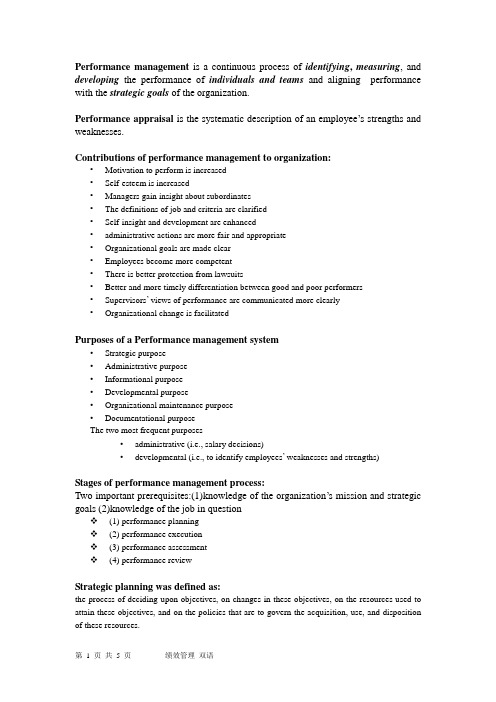
Performance management is a continuous process of identifying, measuring, and developing the performance of individuals and teams and aligning performance with the strategic goals of the organization.Performance appraisal is the systematic description of an employee’s strengths and weaknesses.Contributions of performance management to organization:•Motivation to perform is increased•Self-esteem is increased•Managers gain insight about subordinates•The definitions of job and criteria are clarified•Self-insight and development are enhanced•administrative actions are more fair and appropriate•Organizational goals are made clear•Employees become more competent•There is better protection from lawsuits•Better and more timely differentiation between good and poor performers•Supervisors’ views of performance are communicated more clearly•Organizational change is facilitatedPurposes of a Performance management system•Strategic purpose•Administrative purpose•Informational purpose•Developmental purpose•Organizational maintenance purpose•Documentational purposeThe two most frequent purposes•administrative (i.e., salary decisions)•developmental (i.e., to identify employees’ weaknesses and strengths)Stages of performance management process:Two important prerequisites:(1)knowledge of the organization’s mission and strategic goals (2)knowledge of the job in question(1) performance planning(2) performance execution(3) performance assessment(4) performance reviewStrategic planning was defined as:the process of deciding upon objectives, on changes in these objectives, on the resources used to attain these objectives, and on the policies that are to govern the acquisition, use, and disposition of these resources.The BSC(平衡计分卡)is based on the theory that an organization’s measurement system should enable its managers to answer four fundamental questions:–How do we look to our shareholders (the financial perspective)–How do our customers see us? (customer perspective)–What must we excel at? (the internal business perspective)–How can we continue to innovate and create value? (the innovation and learning perspective)Performance is about behavior or what employees do, and not about what employees produce or the outcomes of their work.Determinants of Performance:1、Declarative knowledge: Information about facts, labels, principles, goals Understanding oftask requirements2、Procedure knowledge:Skills: Cognitive, Physical,Perceptual,Motor,Interpersonal3、Motivation:Choices:Expenditure of effort,Level of effort,Persistence of effort Dimensions of Performance:1、T ask Performance(任务绩效)Task performance activities that:•transform raw materials into the goods and services that are produced by the organization•help with the transformation process•replenishing the supply of raw materials,•distributing its finished products•providing important planning, coordination, supervising, or staff functions2、C ontext Performance(周边绩效)Contextual performance Behaviors that:•contribute to organization’s effectiveness•provide a good environment in which task performance can occurDifferences between task performance and context performance:•Varies across jobs•in-role performance•Influenced by abilities and skills•Fairly similar across jobs•Extra-role performance•Influenced by PersonalityApproaches to Measuring Performance:1、Behavior Approach(Emphasizes how employees do the job)2、Result Approach(Emphasizes what employees produce)3、Trait approach (Emphasizes individual traits of employees)Performance Standards: Yardstick used to evaluate how well employees have achieved objectivesDetermining Performance Standards:Standards refer to aspects of performance objectives, such as:•Quality–How well the objective is achieved•Quantity–How much, how many, how often, at what cost•Time–Due dates, schedule, cycle times, how quicklyCharacteristics of Good Performance Standards:•与职位相关Related to Position•具体、明确、可衡量Concrete, Specific, Measurable•容易衡量Practical to Measure•有意义Meaningful•现实的、可达成的Realistic and Achievable•能定期审查Reviewed RegularlyTypes of Competencies:•Differentiating(区别性胜任能力)–Distinguish between superior and average performance (区分优秀绩效和一般绩效)•Threshold(临界性胜任能力)–Needed to perform to minimum standard(达到最低绩效标准的必备条件)Choose Measurement System:•Comparative system–Compares employees with each other (把员工和其他人比较) •Absolute system–Compares employees with pre-specified performance standard(把员工和事前确定的绩效标准比较)Director supervisor’s role in employee development:•(1) Explain what would be required for the employee to achieve the desired performancelevel•(2) Refer the employee to appropriate developmental activities that can assist the employee in achieving her goals–Select a mentor•(3) Reviews and makes suggestions about the developmental objectives•(4) Check on employee’s progress toward achieving the developmental goals•(5) Provide reinforcementsCoaching 绩效辅导:绩效面谈:主管人员应该做的准备:•Appropriate time•Appropriate place•Necessary materials•Who to talk with•Prepare the procedure of performance talk准备面谈的资料:•performance form 员工绩效评价表格•Document of daily performance 员工日常工作表现的记录对待面谈的对象有所准备:•Personality 员工的个性特征•Possible influence 此次绩效评价结果对员工的影响•Possible emotions and behaviors员工可能表现出来的情绪和行为。
绩效管理及评估资料总集3(英文版)(7个ppt)6

½øÈ¡ Ð ÔÔ Ð Nhomakorabea§ Ð ¼ µ
½ ±Àø ÐÔ
¨ ¼ È Ï É ¿ Í º í ± Ö Ï Í º é × ¯ Ö
À í Ï ë × ´ ¿ ö
Ã÷È· Ð Ô
¹ Ê ü Ã ½ · Í º ¬ Í ò Ï Ú Æ Ä Ð
Ï Ö Ê µ × ´ ¿ ö
¬ Í
Ï º î · Å Í × Ï Ó ¶
消极性
平均组织气氛--基本维度
100 90 80 70
È Ì ¶ È ¿ Ö ± Ù · °
60 50 40 30 20 10 0 Á é » î Ð Ô
指出组织气氛差异
Ô ð È Î Ð Ô ½ ø È ¡ Ð Ô ½ ±À ø Ð Ô Ã ÷È ·Ð Ô Ä ý ¾ Û Ð Ô
À í Ï ë × ´ ¿ ö
鼓励成员发展新思想、新方法的程
度
凝 凝聚 聚性 性
同事间相互喜欢、信任,并合作, 共享信息和资源,互相帮助以完成工作 的程度;一旦需要,员工会付出额外努 力的程度;以及对属于某工作单位或组 织感到自豪的程度。
凝聚性
Team commitment
协调性
员工感觉同事间彼此喜欢、信任的程度
合作性
38%
0
20
40
60
80
100
组织气氛差异
Á é » î Ð Ô
Ô ð È Î Ð Ô
½ ø È ¡ Ð Ô
½ ±À ø Ð Ô
à ÷È ·Ð Ô
Ä ý ¾ Û Ð Ô 0 10 20 30 40 ¾ ß Ó Ð Ï Ô Ö ø × é Ö ¯ Æ ø · Õ ² î Ò ì µ Ä ¹ Ü À í Õ ß ° Ù · Ö ± È 50 60
绩效管理及评估资料总集3(英文版)(7个PPT共)

60 6 60 6 60 6 42 27 15 42 27 15
42
27
15
5. Physical skills
6. Responsibility – Patient/client care
49 9 4 60 45 32 21 12 5 60 45 32 21 12 5 60 45 32 21 12 5 60 60 60 46 34 24 16 9 4 45 32 21 12 5 45 32 21 12 5 25 18 12 7 3 25 18 12 7 3 25 18 11 5 25 18 12 7 3
IS Comparative IS Not Absolute
Judgemental
Structured Job Centred
Scientific
Unstructured Person Focused
Possible Applications for Job Evaluation
Reward
13. Physical effort 14. Mental effort
15. Emotional effort 16. Working conditions
Different Types of Evaluation Method
Method of Analysis Used
By considering By considering Job Elements the Entire Job Point Method
Communicating & Influencing
Area of Impact (Magnitude)
Different Types of Evaluation Method
人力资源专业绩效考核管理方面英文文献及中文翻译
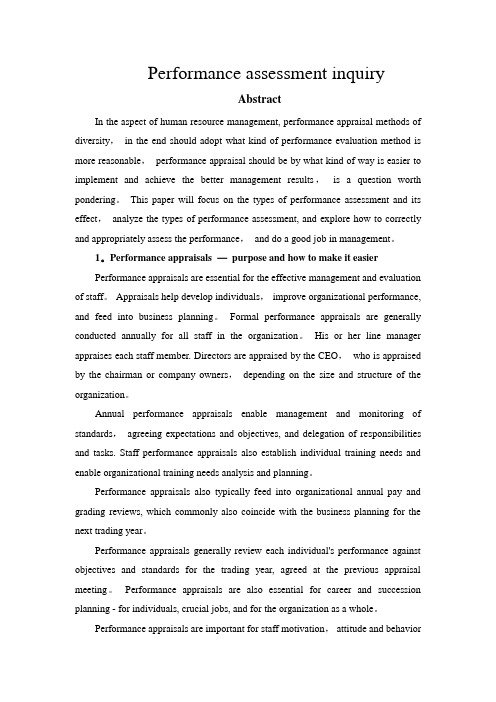
Performance assessment inquiryAbstractIn the aspect of human resource management, performance appraisal methods of diversity,in the end should adopt what kind of performance evaluation method is more reasonable,performance appraisal should be by what kind of way is easier to implement and achieve the better management results,is a question worth pondering。
This paper will focus on the types of performance assessment and its effect,analyze the types of performance assessment, and explore how to correctly and appropriately assess the performance,and do a good job in management。
1。
Performance appraisals —purpose and how to make it easierPerformance appraisals are essential for the effective management and evaluation of staff。
Appraisals help develop individuals,improve organizational performance, and feed into business planning。
- 1、下载文档前请自行甄别文档内容的完整性,平台不提供额外的编辑、内容补充、找答案等附加服务。
- 2、"仅部分预览"的文档,不可在线预览部分如存在完整性等问题,可反馈申请退款(可完整预览的文档不适用该条件!)。
- 3、如文档侵犯您的权益,请联系客服反馈,我们会尽快为您处理(人工客服工作时间:9:00-18:30)。
Performance Appraisal 绩效评估
Informal Appraisal 非正式评估
• Day-to-day contacts, largely undocumented 经常性
Systematic Appraisal 系统化评估
• Formal contact at regular time intervals, usually documented 规律性,通常为每年一次
Who Conducts Appraisals 由谁评估
1.Supervisors who rate their subordinates 上级评估他们的直辖下属 2.Employees who rate their supervisors 员工评估他们的直接上级 3.Team members who rate each other 团队成员互评 4.Outside sources 外部人员评估 5.Employees’ self-appraisal 员工自我评估 6.Multisource (360° feedback) appraisal 多种信息渠道(360度反馈)评估
Management by Objectives 目标管理
Management by Objectives 目标管理
Specifying the performance goals that an individual and his or her manager agree to try to attain within an appropriate length of time. 员工与其管理人员共同制定员工在合理的时间期限内 要达到的业绩目标。
Listing of all employees from highest to lowest in performance. 把所有员工按绩效从高到低依序排列。
Forced Distribution 强制分配法
Performance appraisal method in which ratings of employees are distributed along a bell-shaped curve. 采用强制分配法时,评估者对员工业绩的评价结果通 常要符合正态分布。
Uses of Performance Appraisal 绩效评估的作用
Performance Appraisal (PA)
The process of evaluating how well employees perform their jobs when compared to a set of standards, and then communicating the information to employees. 是以一套标准为参照依据,评价员工的工作绩效,并 将相关信息知会员工的过程。
Development of Performance Standards 确立绩效标准
Guided Objective Setting 引导员工设置目标
Continuing Performance Discussions 持续 Nhomakorabea行绩效讨论
Rater Errors 评估者误差
1. Varying standards 标准不一 2. Recency/ Primacy effects 近因/首因效应 3. Central tendency, leniency, strictness 中心化趋势、宽松化和严格化 误差 4. Rater bias 评估者偏见 5. Halo/Horn effect 晕轮/喇叭效应 6. Contrast error 比较误差 7. Similar to me/ different from me 类己/异己误差 8. Sample error 抽样误差
Types of Performance Information 绩效信息的类型
TraitTrait-based Information 员工特质信息
BehaviorBehavior-based Information 员工行为信息
Job Performance
ResultsResults-based Information 工作结果信息
Checklists 检核清单法
A performance appraisal tool that uses a list of statements or work behaviors that are checked by raters. 指评估者根据一份陈述清单进行绩效评估的方法。
Comparative Methods 比较法 Ranking 排序法
Roles for Performance Appraisal
Performance Appraisal 绩效评估
Administrative roles 管理用途
• compensation 薪酬 • promotion 晋升 • dismissal 撤职 • downsizing 精简机构 • layoff 临时解雇
Performance Appraisal Methods 评估绩效的方法 1.Category Rating Methods 分类评定法 parative Methods 比较法 3.Narrative Methods 描述法 4.Behavioral/Objective Methods 行为/目标法
LOGO
Human Resource Management
Performance Management and Appraisal 绩效管理与评估
怀丽
Performance Management System 绩效管理系统
Processes used to identify, encourage, measure, evaluate, improve, and reward employee performance. 包含了明确绩效内容、激励员工、衡量和评估工作绩 效、改善工作绩效以及奖励员工的全过程。
Performance feedback 绩效反馈
Feedback system
Data 数据
Evaluation Text of data 评估 Add Your Text
Action based on evaluation 措施
Key MBO Ideas 目标管理的三个核心理念
Employee involvement 员工参与 Clearly difined goals 清楚明确的目标 Measurable goals 目标具有可测量性
The MBO Process 目标管理的步骤
Job Review and Agreement 复核工作内容并达成一致意见
Category Rating Methods 分类评定法 Graphic Rating Scale 图评价量表法
A scale that allows the rater to indicate an employee’s performance on a continuum. 在一个连续区间内评价被评估者的业绩。
Performance Standards 绩效标准
Performance Standards 绩效标准
Expected levels of performance 企业期待员工达到的 绩效水平
Characteristics of Well-defined Standards
Realistic 可实现 Measurable 可测量 Clearly understood 清楚明了
Narrative Methods 描述法
Critical Incident 关键事件法 Essay Method 评语法 Field Review 专家评估法
Behavioral/Objective Methods 行为 目标法 行为/目标法 1.Behaviorally anchored rating scales (BARS) 行为锚定评估量表法 2.Behavioral observation scales (BOS) 行为观察量表法 3.Behavioral expectation scales (BES) 行为期望量表法
绩效
一个员工做什么或没做什么
• 产出的数量 • 产出的质量 • 产出的及时性 • 出勤率 • 合作精神
Job Criteria 工作指标(或称为绩效维度)
Important elements in a given job 是一项工作中最重要的要素 如一位大学教授的工作包括 1. 教学 2. 科研 3. 服务
Performance
What an employee does and does not do.
• Quantity of output • Quality of output • Timeliness of output • Presence at work • Cooperativeness
Development Uses 开发用途
• identifying strengths 识别员工的强项 • identifying areas for growth 确定有待提高的领域 • development planning 制定员工开发计划 • coaching and career planning 在职辅导和职业生涯规划
